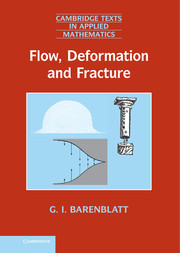 Flow, Deformation and Fracture
Flow, Deformation and Fracture Book contents
- Frontmatter
- Dedication
- Contents
- Foreword
- Preface
- Introduction
- 1 Idealized continuous media: the basic concepts
- 2 Dimensional analysis and physical similitude
- 3 The ideal incompressible fluid approximation: general concepts and relations
- 4 The ideal incompressible fluid approximation: analysis and applications
- 5 The linear elastic solid approximation. Basic equations and boundary value problems in the linear theory of elasticity
- 6 The linear elastic solid approximation. Applications: brittle and quasi-brittle fracture; strength of structures
- 7 The Newtonian viscous fluid approximation. General comments and basic relations
- 8 The Newtonian viscous fluid approximation. Applications: the boundary layer
- 9 Advanced similarity methods: complete and incomplete similarity
- 10 The ideal gas approximation. Sound waves; shock waves
- 11 Turbulence: generalities; scaling laws for shear flows
- 12 Turbulence: mathematical models of turbulent shear flows and of the local structure of turbulent flows at very large Reynolds numbers
- References
- Index
11 - Turbulence: generalities; scaling laws for shear flows
Published online by Cambridge University Press: 05 June 2014
- Frontmatter
- Dedication
- Contents
- Foreword
- Preface
- Introduction
- 1 Idealized continuous media: the basic concepts
- 2 Dimensional analysis and physical similitude
- 3 The ideal incompressible fluid approximation: general concepts and relations
- 4 The ideal incompressible fluid approximation: analysis and applications
- 5 The linear elastic solid approximation. Basic equations and boundary value problems in the linear theory of elasticity
- 6 The linear elastic solid approximation. Applications: brittle and quasi-brittle fracture; strength of structures
- 7 The Newtonian viscous fluid approximation. General comments and basic relations
- 8 The Newtonian viscous fluid approximation. Applications: the boundary layer
- 9 Advanced similarity methods: complete and incomplete similarity
- 10 The ideal gas approximation. Sound waves; shock waves
- 11 Turbulence: generalities; scaling laws for shear flows
- 12 Turbulence: mathematical models of turbulent shear flows and of the local structure of turbulent flows at very large Reynolds numbers
- References
- Index
Summary
Turbulence is the state of vortex fluid motion where the velocity, pressure and other properties of the flow field vary in time and space sharply and irregularly and, it can be assumed, randomly.
Turbulent flows surround us, in the atmosphere, in the oceans, in engineering systems and sometimes in biological objects. A contrasting class of fluid motions, when the fluid moves in distinguishable layers (laminae in Latin) and the flow-field properties vary smoothly in time and space, is known as laminar flow. In Figure 11.1 an example of the time dependence of the velocity in a turbulent flow is presented. For laminar flow the time dependence would be a smooth line.
Leonardo da Vinci already knew about and clearly distinguished these two types of flow. Leonardo even used the term “turbulenza”. However, his observations and thoughts were buried in his notebooks, solemnly and carefully preserved in the Royal and Papal archives. They were not published until recently and therefore most regrettably did not influence future studies.
The systematic scientific study of turbulence began only in the nineteenth century, and here two names should be mentioned in particular, those of the French applied mathematician Joseph Boussinesq and the British physicist Osborne Reynolds. Boussinesq was a student of A. Barré de Saint Venant, who, in his turn, was a devoted disciple of C. L. M. H. Navier, the originator of the mathematical models for both Newtonian viscous fluid flows and the deformation of perfectly elastic bodies.
- Type
- Chapter
- Information
- Flow, Deformation and FractureLectures on Fluid Mechanics and the Mechanics of Deformable Solids for Mathematicians and Physicists, pp. 182 - 224Publisher: Cambridge University PressPrint publication year: 2014
